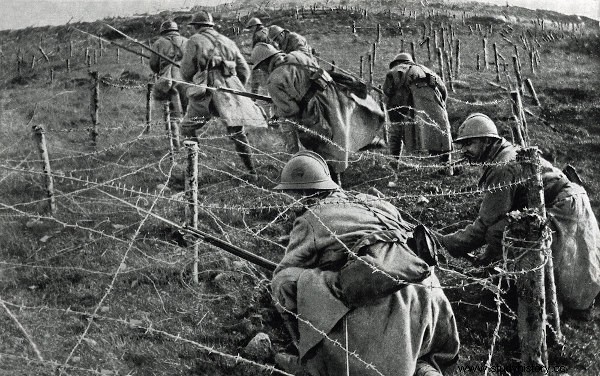
The Triple Alliance was a military agreement, between 1882 and 1994, which involved:
-
Germany;
-
Austria-Hungary;
-
Italy .
This alliance was part of the military agreement strategy established by German Chancellor Otto von Bismarck. It established mutual cooperation between the three nations.
Its objective was to isolate France and Russia diplomatically and prevent both from starting a conflict against any of the countries that formed the alliance. This agreement ceased to exist in 1915, when the Italians withdrew from it and joined the Triple Entente during the First World War.
Check out our video lesson: World War I
Triple Alliance Summary
-
It was a military agreement between Germany, Austria-Hungary and Italy.
-
It lasted from 1882 to 1915.
-
It ended when Italy withdrew.
-
Its main objective was to isolate Russia and France diplomatically.
-
It was part of the diplomatic strategy established by German Chancellor Otto von Bismarck.
What was the Triple Alliance?
The Triple Alliance was anagreement signed by Germany, Austria-Hungary and Italy on May 20, 1882 and establishing aalliance of mutual military cooperation between the three countries involved. This agreement was part of the alliance policy established by Germany during the administration of Chancellor Otto von Bismarck.
Its primary objective was to ensure the isolation of France and Russia . That's because the three nations involved pledged to defend each other in case they were attacked by another European power.
This union was periodically renewed by the members, until it expired in 1915 , because Italy decided to ally with other nations in the context of the First World War. These alliances were intended to weaken the possibility of war, but actually contributed directly to raising tempers in Europe .
In addition to mutual cooperation, in the event of an attack by another country on any of the members of the Triple Alliance, some specific agreements were established, many of them centered around Italy. Italy's admission to this group was part of the Italian government's action to defend itself against France.
Germany and Austria-Hungary, allied since 1879, saw the addition of Italy as a possibility to further strengthen their status on the European continent. To this end, they gave the Italian government a guarantee that they would protect the country if it were attacked by France and provided that the attack was not in response to any Italian provocation.
In addition, Italy received guarantees that it would have its imperialist claims for colonies in Africa defended by the other two countries; should also commit to neutrality, should they go to war, and maintain friendly relations with the German government.
End of the Triple Alliance
As mentioned, the signing of the Triple Alliance was intended to diplomatically isolate France and Russia and prevent a new war from starting and Germany being dragged into it. This type of defensive union sought to weaken the possibility of war by transforming it into a very large weight for an eventual aggressor, since whoever attacked Germany would go to war with the other members of the agreement.
The purpose of this agreement ultimately failed, as the war began in 1914 as a result of the assassination of Franz Ferdinand . He was heir to the Austrian throne, and his death created a strong diplomatic crisis between Austria-Hungary and Serbia, also causing Russia to be dragged into this fight.
In addition, Germany also saw its foreign policy profoundly changed with the dismissal of Otto von Bismarck in 1890. With that, Germany's policy of defensive military alliances was replaced by a more aggressive foreign policy that removed Russia and Great Britain from the German government, directly contributing to these countries joining France, the great enemy of the Germans, and form a military alliance that was named the Triple Entente .
Read more: Christmas Truce in World War I
Motives and interests of the Triple Alliance
The signature of the Triple Alliance met political, military and economic interests of the three nations involved, as we shall see. Starting with Germany, the main objective of the Otto von Bismarck government was to ensure security German through diplomatic isolation from the French.
The rivalry between France and Germany went directly through the process of German unification, concluded in 1871, when Prussia defeated France in the Franco-Prussian War, giving rise to the German Empire. Thus, there was fear in Germany of a possible French revenge, in a new war, in order to recover what it had lost to the Germans.
There was also a strong rivalry from Germany with Russia and an intention to prevent it from expanding its interests in the Balkans , a region that became disputed after the weakening of the Ottoman Empire. Another important issue was the ethnic rivalry which involved the Germans (Germans) and Slavs (Russians), considered an element that contributed to the tension.
The rivalry between Russia and Austria-Hungary it was also a big issue, since both were directly competing with each other for expansions into the Balkans. The Austrians had even annexed Bosnia as part of this expansion. Tension between the two nations over the Balkans has alienated each other.
Finally, in the case of Italy, the big issue was France, a country that had harmed theimperialist interests of the Italian government in North Africa. The tension that was established between the two nations made Italy fear a conflict with the French, and the alliance with the Germans and Austrians was a way for her to protect herself from this happening. The Italians also believed that this would allow them to conquer colonies in Africa.
